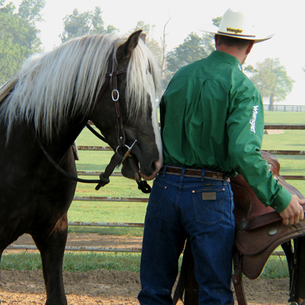The Clockwork Exercise, Part 1
July 10, 2014
Written by: Josh Lyons & Keith Hosman
Written by: Josh Lyons & Keith Hosman
|
This is part 1 of 2 parts. Click here to jump to part 2
Why You Want To Do This Exercise: This must-learn exercise teaches your horse to neck rein, side pass, back up, move diagonally, spin, or do reverse-arc circles. It's also a great way to teach your horse to not drop its shoulder through circles. How You'll Do It: You'll teach your horse to move any of his four feet anywhere you please using either of the two reins. The combinations are virtually endless and give you excellent control over the movements of your horse. Here's how to train your horse to neck rein, side pass, back up, move diagonally, spin, or do reverse arc circles using the John Lyons methods. 
There are two ways to teach this exercise: You can begin by walking forward or you can begin by backing up.
To get started, stand up. Look to the left. Keep your head in that position and sidestep to your right. Now, look to your right and sidestep to your right. It was easier to move to the right with your head to the left, wasn't it? Your horse finds the same thing. That's why you begin teaching your horse to move to the left by using the right, or "opposite," rein. Picture a rope laying on the ground. Imagine your horse walking on this rope with both front and back feet, like a train on its tracks. Now, picture two ropes laying on the ground parallel to each other. Picture your horse walking with its front feet on one rope and its back feet on the other rope, as if the engine of the train were on one set of tracks while the caboose ran on another set. That's what you'll teach your horse to do with this exercise - so when we say "move your horse's left shoulder to the right" we mean to push it off the track. You'll need one more analogy before we begin: This is called "The Clockwork Exercise" because you need to imagine four very large clocks, one underneath each of your horse's feet. When your horse moves any leg directly forward that leg is "stepping on twelve o'clock." When any leg moves directly back that leg is stepping on six o'clock. Three o'clock is directly to the right, nine o'clock directly to the left, etc. All four legs can step on any of the twelve numbers.
We'll begin very simply. Move your horse off at a walk and pick up your left rein. (At this point this is not a two-handed exercise.) Stare at a very small part of your horse's right shoulder and think of nothing but making it move to the right. Hold your rein with whatever angle and amount of pressure it takes to encourage your horse to move the spot you're focusing on to the right. It is vital to realize that your horse will not take a big step to the right when you first begin. Don't even look for it, not yet. What you should be looking for (and feeling for) is a very small, very slight leaning to the right. The horse will either lean or slightly lift and lean. Horse training is all about taking small changes and building on them. So, when your horse leans, you let go - immediately. Go forward a few steps as you pet your horse. Repeat. It's also important to drop your reins and pet your horse in between requests. You might find it helpful to very briefly "check your horse back" or slow his speed, before asking for sideways movement in an attempt to divert his forward energy off to the side. Tip: Teach almost anything to your horse with the "Clock Work Exercise." That's a chapter in the basic training book "What I'd Teach Your Horse" - and you can hear the whole section right now for FREE on audio when you click here.
When your horse does finally move "off the track" to the right or left, ask yourself what number he stepped on. Get that number several more times. When you believe you can get it consistently, begin toying with the angle and pressure you're using and begin "whittling it down" to the next adjacent number on the clock. When you can consistently get a one o'clock, for instance, you'll have the control necessary to step on two o'clock fifty percent of the time. When you get two consistently, you'll get three half the time and so on.
Tips: 1) You'll probably find ones and elevens the most difficult. 2) Your horse will have to actually stop his forward motion to get threes, fours, etc., so be prepared for that and work with it. 3) Try to not crank his head way off to the side. It's darned near impossible for him to step cleanly to the right with his head attached to your left boot - so do your best to keep his head (at most) 2-3 inches off to the side. If that seems like an impossible request, try using two reins: use your outside rein to pull the horse's head into position (that is, in front of his body) with his chin nearing his chest. 4) Don't ever bring your rein across the horse's neck. Try holding the rein closer to the horse's mouth or change your angle. 5) When you first begin sidepassing, you may feel as if you're tipping in the saddle one way or the other. That's natural. Your horse is dropping a shoulder. As it becomes more proficient, it'll learn to keep it elevated. (Or, another fix: Practicing this exercise will give you the ability to move that shoulder over, in effect "lifting it.") While you'll see the benefits of this exercise quickly, mastering it takes a great deal of time: Once you can get the left rein to tell the front right foot to step on any number (any of the twelve), reverse it. Use your right rein to talk to the front left leg. Next, use your left rein to make the back right leg hit each position and vice-versa with the right rein. Finally, connect the reins to the legs on the same side: Pick up the right rein and get the front right to step on each number, then the back right foot. Do the same for the left side. Remember, when you're done, either rein can tell any leg to step on any of the twelve numbers. Get your horse to stop now, not later. If it takes 2 seconds to go from a walk to a stop - multiply that by 8 when he's excited. Click here to read the "Hip-Shoulder-Shoulder" 3-part series of article - and get that stop the easy way!
A word of caution: Your horse will never get lighter than the lighter pressure you use. You need to constantly look for improvement. If your horse is consistently getting three o'clock, can he do so with less movement from your hand and with less pressure? Also, the longer you let the horse pull on the rein, the more the horse learns to lay on the rein. If he begins laying the rein, motivate him to find a release: squeeze or bump with your legs, disengage the hip, etc. End of part 1, click here to jump to part 2 Wanna teach your horse to drop its head and stay relaxed? When you're finished with this article, click here to read about the "Classic Serpentine."
|
|

